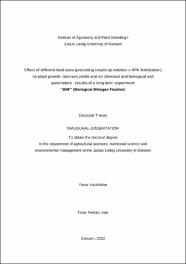| dc.description.abstract | Land use practices such as green mulch, fallow, and rotating crop sequences have a major impact on soil properties, which in turn affect crop biomass yields. The effects of these methods depend, among other things, on the frequency and length of time they are practised. To clarify these relationships, long-term experiments (LTE) are suitable in which the effects of different soil use can be studied over long periods of time.
The study carried out therefore aimed to clarify whether different land uses / pre crops that are part of cereal crop rotations have a lasting effect on soil fertility and on the grain / biomass yields of the crops. To answer this question, the ongoing LTE "Biological N fixation" established in 1982 at the Giessen site was used and evaluated in its 9th and 10th rotation during 2015 to 2020. The trial is designed as a four-year crop rotation with five different preceding crops in the first year: year-round fallow land, year-round clover mulch, field beans, grain oat and corn cob maize. After that, winter wheat (2nd year), winter rye (3rd year) and spring barley (4th year) are grown uniformly, each combined with different NPK fertilization (without, PK, PK + 50% N, PK + 100% N).
It has been found that after at least nine crop rotations, the Ct content in the topsoil tended to be higher after clover mulch followed by field beans, than for all other land uses / pre crops but this trend could not be proven with certainty in all years. The effect of mineral N fertilization, which also increased the Ct content in the soil, was clearer than the pre-crop effect. Besides Ct, DOC and TOC of the topsoil were also increased by clover mulch and N fertilization. Clover mulch and mineral N increased also the Nt content in the topsoil, while fallow reduced it. DON (0-30 cm) was mainly increased by mineral N, while TNb was increased by clover mulch in the entire soil profile (up to 90 cm).
In emission measurements of the soil, a strong seasonal effect of CO2 efflux (Fc) of the soil surface was found. The data have shown that the Fc values were positively correlated with the soil/air temperature and reached its maximum level in summer. It was found out that clover mulch tended to higher Fc values, indicating a higher soil respiration and microbiological activity. Further on, it was observed that SMB C of the topsoil was significantly increased by pre crops only in the first year immediately after the previous crops as well as due to mineral N fertilization. Regarding the soil mesofauna, it was found that clover mulch has led to higher population density of arthropods as well as higher feeding activity of the mesofauna compared to fallow land and oat.
Suitable indicators of plant responses to soil properties were tiller / spike density, LAI, SPAD, NDVI, plant height, grain protein content and biomass / grain yields. In contrast, HI and TGW were less suitable in this respect. Significant pre crop effects on biomass yields of the subsequent crops were observed in the immediately following crop (2nd year) as well as in the 3rd and 4th year.
From the present results it is deduced that a year-round clover mulch in a crop rotation led to sustainable improvement and fallow land to a clear deterioration in important soil fertility parameters after at least nine repetitions which is reflected by the biomass yields of the crop rotation. | de_DE |



